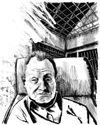
On July 13, 1833, during a visit to the Cabinet of Natural History at the Jardin des Plantes, in Paris, Ralph Waldo Emerson had an epiphany. Peering at the museum’s specimens— butterflies, hunks of amber and marble, carved seashells— he felt overwhelmed by the inter-connectedness of nature, and humankind’s place within it.
The experience inspired him to write “The Uses of Natural History,” and to articulate a philosophy that put naturalism at the center of intellectual life in a technologically chaotic age— guiding him, along with the collective of writers and radical thinkers known as transcendentalists, to a new spiritual belief system. Through empirical observation of the natural world, Emerson believed, anyone could become “a definer and map-maker of the latitudes and longitudes of our condition”—finding agency, individuality, and wonder in a mechanized age.
America was crackling with invention in those years, and everything seemed to be speeding up as a result. Factories and sugar mills popped up like dandelions, steamships raced to and from American ports, locomotives tore across the land, the telegraph connected people as never before, and the first photograph was taken, forever altering humanity’s view of itself. The national mood was a mix of exuberance, anxiety, and dread.
This story is from the {{IssueName}} edition of {{MagazineName}}.
Start your 7-day Magzter GOLD free trial to access thousands of curated premium stories, and 9,000+ magazines and newspapers.
Already a subscriber ? Sign In
This story is from the {{IssueName}} edition of {{MagazineName}}.
Start your 7-day Magzter GOLD free trial to access thousands of curated premium stories, and 9,000+ magazines and newspapers.
Already a subscriber? Sign In

The Dark Origins of Impressionism
How the violence and deprivation of war inspired light-filled masterpieces

The Magic Mountain Saved My Life
When I was young and adrift, Thomas Manns novel gave me a sense of purpose. Today, its vision is startlingly relevant.

The Weirdest Hit in History
How Handel's Messiah became Western music's first classic

Culture Critics
Nick Cave Wants to Be Good \"I was just a nasty little guy.\"

ONE FOR THE ROAD
What I ate growing up with the Grateful Dead

Teaching Lucy
She was a superstar of American education. Then she was blamed for the country's literacy crisis. Can Lucy Calkins reclaim her good name?

A BOXER ON DEATH ROW
Iwao Hakamada spent an unprecedented five decades awaiting execution. Each day he woke up unsure whether it would be his last.

HOW THE IVY LEAGUE BROKE AMERICA
THE MERITOCRACY ISN'T WORKING. WE NEED SOMETHING NEW.

Against Type
How Jimmy O Yang became a main character

DISPATCHES
HOW TO BUILD A PALESTINIAN STATE There's still a way.